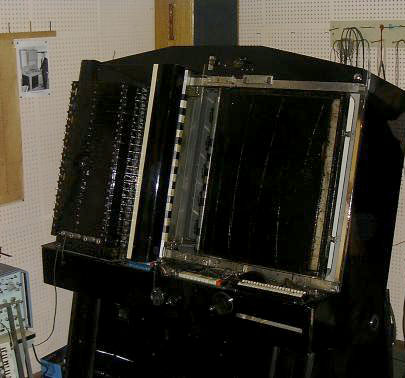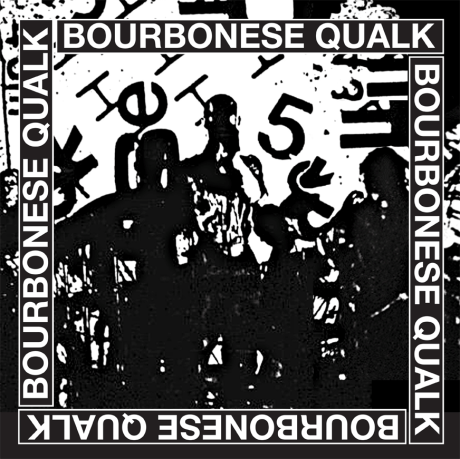Qualkology pt1. Vinyl re-release
September 24, 2014
It’s taken a while but, the first of a series of official re-releases of Bourbonese Qualk archive material comes out in a few weeks on the Berlin based Mannequin Label. ‘Bourbonese Qualk 1983-1986’ not surprisingly, is a compilation of tracks taken from the first five albums during the early Crab/Stanza/Gilbert period of 1983-86 and will be available as a Vinyl LP and CD.
Track listing is as follows:
Bourbonese Qualk 1983-1986
- 1. ‘Dream Decade’ Originally released in 1987 on the ‘Bourbonese Qualk’ LP
- 2. ‘Born Left Hearted’ Originally released in 1986 on the ‘Preparing for Power’ LP
- 3. ‘Pogrom ‘ Originally released in 1986 on the ‘The Spike’ LP
- 4. ‘Soft City’ Originally released in 1986 on the ‘Preparing for Power’ LP
5. ‘Headstop’ Originally released in 1984 on the ‘Hope’ LP - 6. ‘Gag’ Originally released in 1984 on the ‘Hope’ LP
- 7. ‘Outcry’ Originally released in 1986 on the ‘Preparing for Power’ LP
- 8. ‘Return To Order’ Originally released on the ‘Preparing for Power’ LP 1986
- 9. ‘Confrontation’ Originally released in 1986 on the ‘Preparing for Power’ LP
- 10. ‘In-flux’ Originally released in 1986 on the ‘The Spike’ LP
- 11. ‘Qualk Street’ Originally released in 1983 on the ‘Laughing Afternoon’ LP
- 12. ‘Backlash’ Originally released in 1986 on the ‘Preparing for Power’ LP
- 13. ‘Sweat it 0ut’ Originally released in 1987 on the ‘Bourbonese Qualk’ LP New
- 14. ‘There is No Night’ Originally released in 1984 on the ‘Hope’ LP
- 15. ‘God With Us’ Originally released in 1983 on the ‘Laughing Afternoon’ LP
- 16. ‘Blood Orange Bargain Day’ Originally released in 1983 on the ‘Laughing Afternoon’ LP
- 17. ‘Shutdown’ Originally released in 1986 on the ‘The Spike’ LP
- 18. ‘Invocation’ Originally released in 1984 on the ‘Hope’ LP
- 19. ‘To Hell With The Consequences’ Originally released in 1983 on the ‘Laughing Afternoon’
- 20. ‘Erector’ Originally released on the ‘Hope’ LP
- 21. ‘Black Madonna’ Originally released in 1984 on the ‘Hope’ LP
- 22. ‘Suburb City’ Originally released on the ‘The Spike’ LP
- 23. ‘Workover’ Originally released in 1987 on the ‘Bourbonese Qualk’ LP
- 24. ‘Deadbeat’ Originally released in 1986 on the ‘The Spike’ LP
- 25. ‘Insurrection’ Originally released in 1986 on the ‘Preparing for Power’ LP
- 26. ‘This Is The Enemy’ Originally released in 1987 on the ‘Bourbonese Qualk’ LP
 The tracks were chosen by Alessandro at Mannequin to focus, I think, on the more electro-minimal, verging on ‘pop’ style. Not the choice I would have made! – I find my early, er, singing, too awkward and painful to listen to, but, it does seem to be what BQ have become ‘known for’ so who am I to argue?
The tracks were chosen by Alessandro at Mannequin to focus, I think, on the more electro-minimal, verging on ‘pop’ style. Not the choice I would have made! – I find my early, er, singing, too awkward and painful to listen to, but, it does seem to be what BQ have become ‘known for’ so who am I to argue?
You can get it here:
http://www.mannequinrecords.com/
watch this space [ ] for more re-release news.
Auf einen Augen-Blick
February 11, 2012
‘Auf einen Augen-Blick’ is an animated video piece using sequences of hand corrupted jpg files. If I was a bit smarter i could probably have written a script that batch processed multiple files but I found that there is something important in the laborious process of doing each frame by hand – it introduces some organic element into what should be an efficient process…I like the contradiction of using digital media in such a manual way…especially when the content is all about degradation and corruption of the media itself.
Random Rough Mix
February 7, 2012
Been a while comrades: heres some audio and video of stuff from the studio floor that wouldn’t otherwise see the light of day – edited together in a random fashion. Quite a large dose of Geoff Leigh in there from the work we did together and never quite finished…
The ANS: Soviet dolphin translating instrument. Pt 1
October 31, 2007
 Sitting in a forgotten room under the streets of Moscow in the Zoological University basmement is a large iron machine. The machine has been looked after and protected from demolition for the last fourty years by it’s guardian, Stanislav. the machine, called ‘ANS’ , looks like an old printing press, it is black, and smells of oil and ink. the ANS takes time to start up when its fabric covered cables are connected, its cogs spin and the glass plates whirr. It hums loudly.
Sitting in a forgotten room under the streets of Moscow in the Zoological University basmement is a large iron machine. The machine has been looked after and protected from demolition for the last fourty years by it’s guardian, Stanislav. the machine, called ‘ANS’ , looks like an old printing press, it is black, and smells of oil and ink. the ANS takes time to start up when its fabric covered cables are connected, its cogs spin and the glass plates whirr. It hums loudly.
The function of the ANS would be impossible to determine from it’s appearance: The only part of the machine that gives a clue to it’s intended purpose is a small ‘piano’ keyboard vertically positioned next to a greasy inked glass plate: The ANS is infact a musical instrument, an early synthesiser, conceived by the jazz loving military scientist Yvgeny Murzin during the Second World War (or ‘Great Patriotic War’ in Russia). Murzin’s ambition was to create a universal instrument that would combine the visual and audio aspects of composition in one machine(Murzin christened the machine the ‘ANS’ after Alexander Nikolayevich Scriabin who’s synaesthetic theories were very influential in the USSR at the time), freeing the musician and composer from the restaints of standard composition and giving them an unlimited palette of sounds.
(image:Miles Miles holding a glass disk from the ANS dec 2001)
 The basic theory of the machine was to rebuild a sound from it’s visible image – echoing Scriabin’s ‘colour organ’. At the heart of the machine was the sound generator: 144 glass disks, each disk containing multiple pure sine waveforms which when spun at varying speeds produced multiple and complex combinations of tones. The sound was created by directing a light beam through the spinning glass disk to a photo-electric cell – which in turn created a voltage tone output whcih could be heard through a set of speakers. Incredibly, each of the 144 glass discs were hand drawn, in itself a phenomenal task which took many years to complete.
The basic theory of the machine was to rebuild a sound from it’s visible image – echoing Scriabin’s ‘colour organ’. At the heart of the machine was the sound generator: 144 glass disks, each disk containing multiple pure sine waveforms which when spun at varying speeds produced multiple and complex combinations of tones. The sound was created by directing a light beam through the spinning glass disk to a photo-electric cell – which in turn created a voltage tone output whcih could be heard through a set of speakers. Incredibly, each of the 144 glass discs were hand drawn, in itself a phenomenal task which took many years to complete.
Following Murzin’s light-to-sound design of the ANS was the control mechanism. The composer simply wrote into a glass plate covered in black ink – the higher the line the higher the pitch (generated from the glass disks) the lower the line, the lower the pitch. The horizontal axis of the plate represents time, so the length of the line determines it’s longevity. To play the composition a ‘light reading head’ traveled over the inked plate and picked up a light beam shining through the lines made by the composer ( interestingly, the speed of the ‘play head’ could vary without altering the pitch or timbre of the piece a unique and powerful musical and composition tool). The vertical keyboard manual when presssed created straight lines in the ink – therefore producing fixed interval tones.
 The ANS project was not supported by the state and Murzin had continual problems self financing the instrument. As well as co-opting friends and colleagues to help out, the sheer size of the machine was a major issue and it was only until 1958 that the ANS found a secure home – oddly enough in the Zoological University. It was here at the University where the instruments was pressed into military service. Dolphins it was agreed would be useful weapons – planting mines, locating enemy ships and so-on, if only they could be understood (and vice-versa). The ANS with it’s unlimited range of sounds and timbres was seen as a viable way of decoding and learning dolphin language:Photographic images of dolphin calls were drawn on the the ANS plate, analysed, altered and presumably played back to the dolphins…
The ANS project was not supported by the state and Murzin had continual problems self financing the instrument. As well as co-opting friends and colleagues to help out, the sheer size of the machine was a major issue and it was only until 1958 that the ANS found a secure home – oddly enough in the Zoological University. It was here at the University where the instruments was pressed into military service. Dolphins it was agreed would be useful weapons – planting mines, locating enemy ships and so-on, if only they could be understood (and vice-versa). The ANS with it’s unlimited range of sounds and timbres was seen as a viable way of decoding and learning dolphin language:Photographic images of dolphin calls were drawn on the the ANS plate, analysed, altered and presumably played back to the dolphins…

While all this delphinic research was going on the ANS was beginning to be used by a new generation of electronic composers ( including Edward Artemiev – composer of soundtracks to Tarkovsky’s films ‘Stalker’ and ‘Solaris’, Oleg Buloshkin, Vladimir Martinov, Edison Denisov, Sofia Gubaidulina, Alfred Schnittke, Alexander Nemtin and Stanislav Kriechi – the ANSs’ keeper) who had realised the potential of the instrument.
